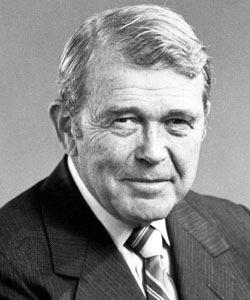Bill Hewlett facts for kids
Quick facts for kids
Bill Hewlett
|
|
|---|---|
 |
|
| Born |
William Redington Hewlett
May 20, 1913 Ann Arbor, Michigan, U.S.
|
| Died | January 12, 2001 (aged 87) Palo Alto, California, U.S.
|
| Education | Stanford University (BA, MA) Massachusetts Institute of Technology (MS) |
| Known for | Co-founder of: Hewlett-Packard |
| Net worth | |
| Spouse(s) |
Flora Lamson
(m. 1939; died 1977)Rosemary Bradford
(m. 1978–2001) |
| Children | Eleanor, Walter, James, William and Mary |
| Scientific career | |
| Academic advisors | Frederick Emmons Terman |
William Redington Hewlett (born May 20, 1913 – died January 12, 2001) was an American engineer. He is famous for co-founding the Hewlett-Packard Company (HP) with his friend David Packard. HP became one of the world's biggest technology companies.
Contents
His Early Life and Studies
William Hewlett was born in Ann Arbor, Michigan. His father taught at the University of Michigan Medical School. In 1916, his family moved to San Francisco. His father then worked at Stanford University School of Medicine.
William went to Lowell High School. He was a leader in the school's Army JROTC program. After his father passed away, William was accepted into Stanford University.
He earned his first degree from Stanford University in 1934. He then got a Master of Science degree in electrical engineering from MIT in 1936. In 1939, he received another degree from Stanford.
Starting Hewlett-Packard
While at Stanford, William Hewlett took classes taught by Fred Terman. There, he met David Packard. In August 1937, they started talking about creating a company together. On January 1, 1939, they officially founded the Hewlett-Packard Company. They flipped a coin to decide whose name would come first!
Their first big success happened when Disney bought many audio oscillators from them. William had designed these special devices. Disney used them to make the sound for their famous movie, Fantasia.
The HP Way: A Special Company Culture
HP became a big company in 1947. Both Bill Hewlett and Dave Packard were very proud of their company's culture. This culture became known as "The HP Way." It was all about more than just making money. It focused on respecting and supporting their employees.
William Hewlett was the president of HP from 1964 to 1977. He also served as the CEO from 1968 to 1978. After that, he continued to be involved in the company's leadership until 1987.
Working with Steve Jobs and Apple
A young Steve Jobs, who later co-founded Apple, once called William Hewlett. Steve was only 12 years old at the time. He found Hewlett's phone number in the phone book! Steve asked for any spare parts for a frequency counter he was building.
William Hewlett was very impressed by Steve's determination. He offered Steve a summer job assembling frequency counters at HP. Steve Jobs greatly admired HP. He saw it as one of the few companies built "to last, not just to make money."
Steve Wozniak, who co-founded Apple with Jobs, also worked at HP. He tried five times to sell the Apple I computer to HP, but they weren't interested. Early Apple computers even used parts from HP. William Hewlett later said about this missed chance, "You win some, you lose some."
Serving His Country
During World War II, William Hewlett served in the Army. He was an officer in the Signal Corps. He then led the electronics section of a new part of the War Department. After the war, he was part of a team that checked on Japanese industries.
Helping Other Companies
William Hewlett also served on the boards of other companies. He was a director for Hexcel Products Incorporated from 1956 to 1965. He also served as a director for Chase Manhattan Bank from 1969 to 1980. From 1966 to 1983, he was on the Board of Directors for Chrysler Corporation.
Giving Back: Philanthropy
Starting in the 1960s, William Hewlett spent a lot of his time and money helping others. In 1966, he and his wife Flora started the William and Flora Hewlett Foundation. This foundation grew to become one of the largest private foundations in the United States.
Besides the foundation, William Hewlett gave millions of dollars to many places. These included universities, schools, museums, and other non-profit groups. Stanford University received a lot of his generous donations.
His Personal Life
In 1939, William Hewlett married Flora Lamson. They had five children together: Eleanor, Walter, James, William, and Mary. They also had 12 grandchildren. Flora passed away in 1977. In 1978, William married Rosemary Kopmeier Bradford.
William Hewlett loved nature and spending time outdoors. He was also a keen amateur photographer and botanist (someone who studies plants). He took many photos and collected samples of wildflowers. Some of these were given to the California Academy of Sciences.
He passed away from heart failure in Palo Alto, California, on January 12, 2001. He was 87 years old. He was buried in Los Gatos Memorial Park, San Jose, California.
His Lasting Legacy
In 1999, a building at Stanford University was named in his honor. It is called the William R. Hewlett Teaching Center. This building is located near the David Packard Electrical Engineering Building.
Awards and Honors
William Hewlett received many awards for his work and contributions:
- IEEE Founders Medal (1973)
- Vermilye Medal (1975)
- Golden Plate Award of the American Academy of Achievement (1981)
- National Medal of Science (1983)
- National Inventors Hall of Fame (1992)
- Lemelson-MIT Prize Lifetime Achievement Award (1995)
- The 3rd Annual Heinz Award Chairman's Medal (with David Packard) (1997)
- Entrepreneur Walk of Fame (2011)
See also
In Spanish: Bill Hewlett para niños

